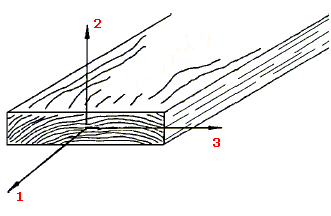A material is isotropic if its mechanical and thermal properties are the same in all directions. A material is orthotropic if its mechanical or thermal properties are unique and independent in three mutually perpendicular directions.
Isotropic materials can have a homogeneous or non-homogeneous microscopic structures. For example, steel demonstrates isotropic behavior, although its microscopic structure is non-homogeneous.
A material is orthotropic if its mechanical or thermal properties are unique and independent in three mutually perpendicular directions. Examples of orthotropic materials are wood, many crystals, and rolled metals.
For example, the mechanical properties of wood at a point are described in the longitudinal, radial, and tangential directions. The longitudinal axis (1) is parallel to the grain (fiber) direction; the radial axis (2) is normal to the growth rings; and the tangential axis (3) is tangent to the growth rings.
